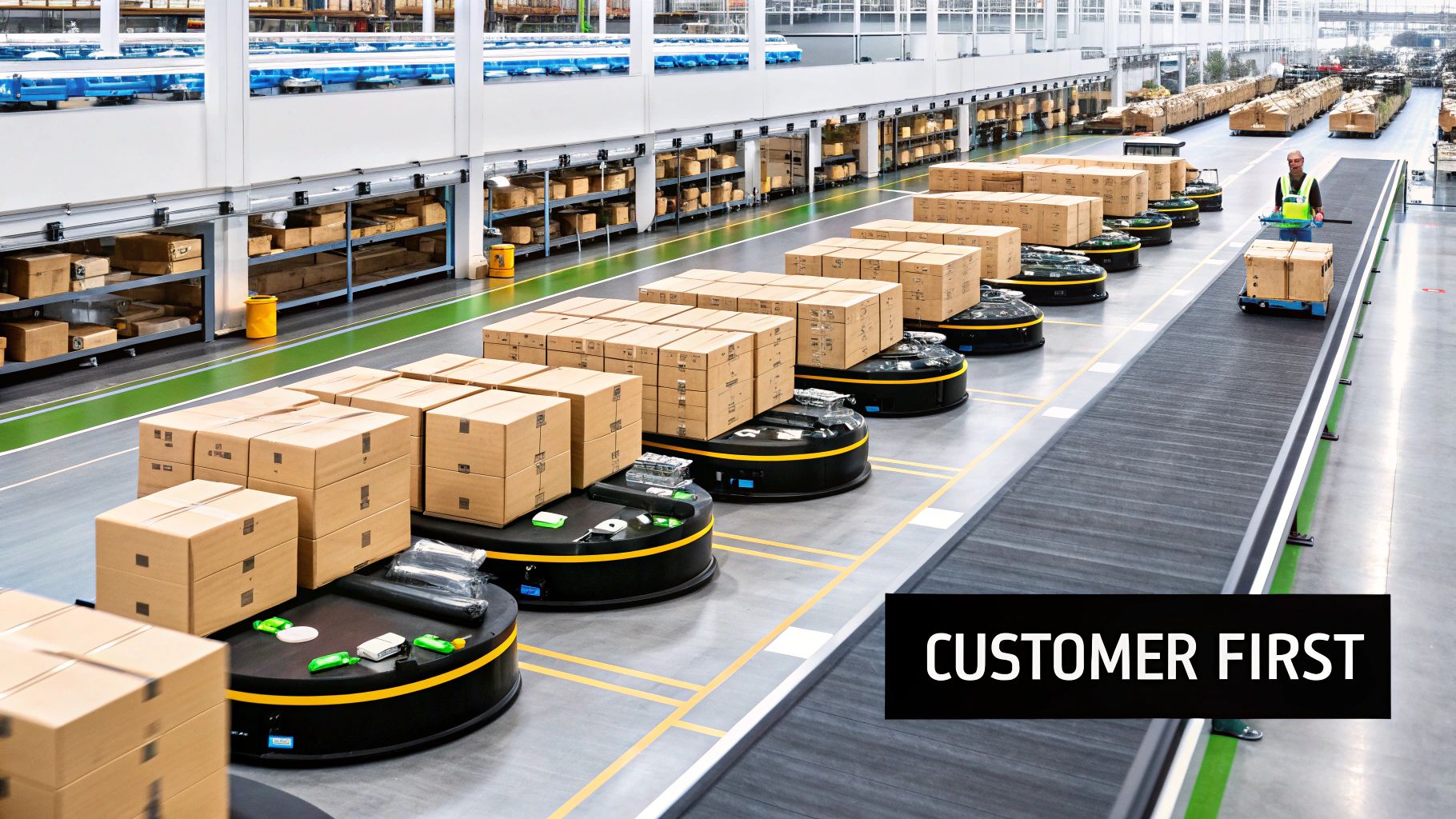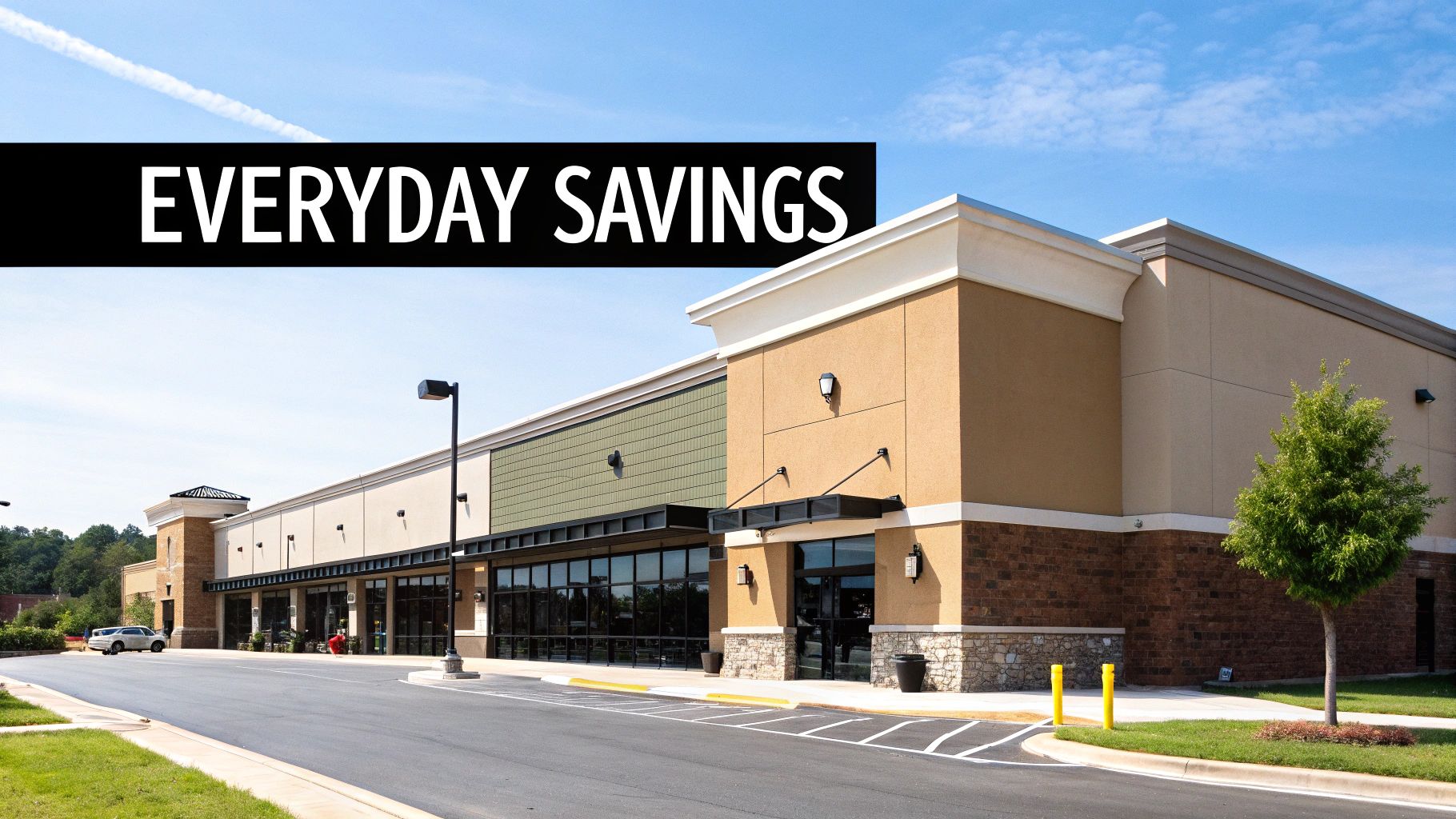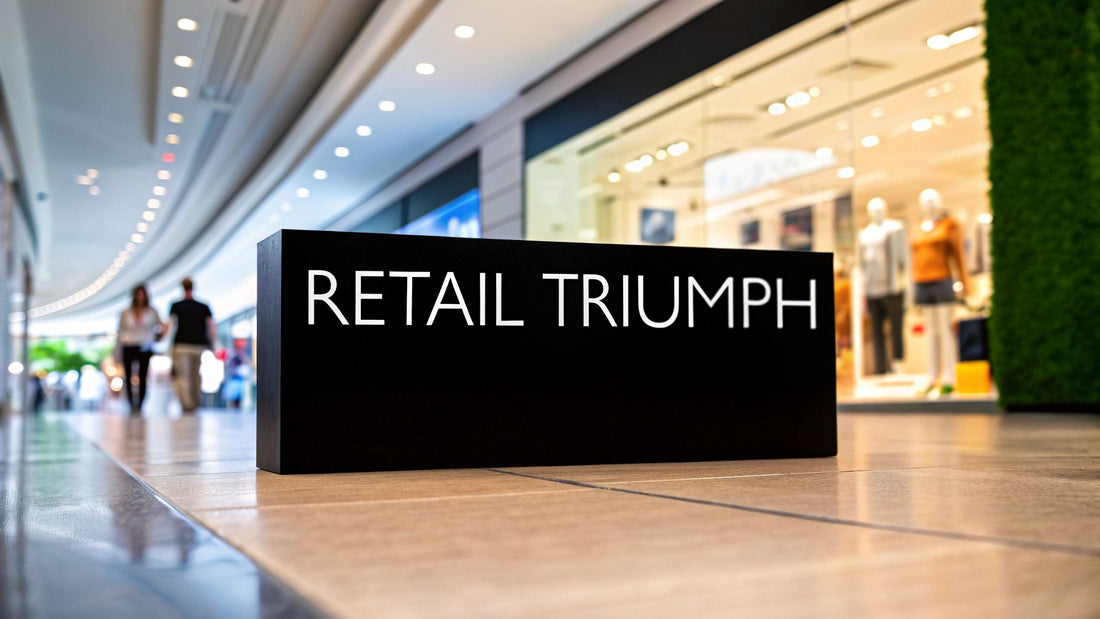Retail Giants: Learning From The Best
The retail world is constantly evolving. For Shopify merchants, staying competitive isn't just a good idea—it's essential. Understanding the top players and their strategies is key to thriving in this dynamic environment. From the growth of e-commerce giants to the renewed focus on in-person shopping experiences, the retail landscape has changed dramatically.
These changes are driven by factors like shifting consumer behavior and new technologies. But what really makes a retail approach successful? What separates the thriving businesses from those struggling to stay afloat?
Eight Examples of Retail Excellence
This article examines eight leading retailers and the strategies that have fueled their success. We'll explore how these approaches have developed, their impact on the retail industry, and how you can apply these lessons to your own Shopify store for maximum growth. Get ready for inspiration and actionable insights to refresh your retail strategy.
Amazon: Lessons for Shopify Merchants

Amazon dominates the online retail world. As the largest online retailer, its journey from a simple online bookstore in 1994 to a global powerhouse offers valuable lessons for all retailers, especially those using Shopify. Amazon's success demonstrates the power of customer focus, logistical innovation, and continuous expansion.
Amazon’s success stems from key features: an extensive product selection, its innovative Marketplace platform for third-party sellers, a robust logistics network, the popular Prime subscription, and a connected ecosystem of services. This ecosystem includes everything from cloud computing (AWS) to smart home devices (Alexa) and e-readers (Kindle), fostering customer loyalty and driving sales.
Why Amazon Matters for Shopify Merchants
Understanding Amazon is crucial for Shopify merchants. Amazon's strengths offer valuable lessons and potential opportunities. Their data-driven personalization, for instance, highlights the importance of knowing customer preferences.
Prime Day, which generated $12.7 billion in sales in 2023, showcases the power of compelling shopping events. The Whole Foods acquisition demonstrates Amazon’s willingness to disrupt traditional retail. Even Amazon Go's cashierless technology offers a glimpse into the future of physical stores.
Pros of Amazon
- Unmatched Product Selection: Customers enjoy a vast array of products.
- Competitive Pricing: Scale and competition keep prices low.
- Fast Shipping: Prime sets the standard for quick delivery.
- Customer-Friendly Returns: Encourages purchases and builds trust.
- Seamless Digital Experience: Provides a consistent and user-friendly interface.
- Innovation in Retail Technology: Constantly pushes the boundaries of e-commerce and logistics.
Cons of Amazon
- Challenging for Small Retailers: Its dominance creates a highly competitive environment.
- Market Dominance Concerns: Raises antitrust and regulatory questions.
- Environmental Impact: Its vast operations have environmental implications.
- Labor Practices: Faces criticism regarding worker conditions.
- Data Privacy: Collects large amounts of user data, raising privacy concerns.
Tips for Shopify Merchants
- Focus on Niche Products: Offer unique items not easily found on Amazon.
- Leverage Amazon's Marketplace (Strategically): Expand your reach, but cultivate independent sales channels on your Shopify store.
- Utilize Amazon's Advertising Platform: Improve product visibility within the massive marketplace.
- Study Their Data-Driven Approach: Learn from Amazon’s personalization strategies to enhance your customer experience.
By analyzing Amazon’s strengths and weaknesses, Shopify merchants can gain valuable insights. Amazon exemplifies the importance of innovation, customer focus, and strategic technology use. Competing directly with Amazon may be difficult, but learning from their example is essential for any online retailer.
Walmart: Lessons for Shopify Merchants

Walmart, the world's largest retailer, offers valuable lessons for Shopify merchants. Founded in 1962 by Sam Walton on the principle of "Everyday Low Prices," Walmart's journey from a small-town store to a global giant demonstrates the importance of understanding consumer needs and pursuing efficiency.
Walmart's success is rooted in its core features. Its extensive physical store network provides broad geographic accessibility. Its sophisticated supply chain enables its "Everyday Low Price" strategy. The company's omnichannel approach integrates online and offline shopping, while its focus on groceries positions it as a one-stop shop. Finally, its private label brands, like Great Value, boost price competitiveness and profitability.
Pros for Shopify Merchants
- Economies of Scale: While Shopify merchants can't match Walmart's scale, understanding how they leverage it for price negotiation and efficiency offers valuable insights.
- Price Leadership: Analyze Walmart's pricing strategy to see how they attract and retain customers.
- Geographic Reach: Consider how physical stores, if relevant to your business, can expand your reach.
- Convenience: Think about offering a wider product or service range to enhance customer convenience.
- Supplier Relationships: Strong supplier relationships are essential for retailers of all sizes.
- E-commerce Growth: Learn from Walmart's investment in e-commerce, especially their online and offline integration strategies.
Cons to Consider
- Employee Compensation: Ethical business practices are crucial for long-term success. Walmart has faced criticism in this area.
- Shopping Experience: A focus on low prices can sometimes impact the overall customer experience.
- Product Quality: Balancing price and perceived quality is key.
- Urban Presence: Walmart's urban presence is often smaller than its suburban/rural footprint. Consider your target demographic.
Walmart's Adaptability: Real-World Examples
- Curbside Pickup: Walmart's rapid curbside pickup expansion during the pandemic highlights its ability to adapt to changing consumer behavior.
- Walmart+: This membership program competes directly with Amazon Prime, showcasing Walmart's focus on building customer loyalty.
- Health Services: Integrating health services into retail locations shows Walmart’s understanding of evolving consumer needs.
- Flipkart Acquisition: The acquisition of Flipkart underscores Walmart’s global ambitions and offers insights into international expansion.
Tips for Shopify Merchants
- Supply Chain: Study Walmart's supply chain efficiency and how they optimize logistics.
- E-commerce Strategy: Observe their shift to e-commerce and how they integrate online and offline operations.
- Consumer Demographics: Note how Walmart adapts its offerings to different customer segments.
- Local Inventory: Explore their local inventory management across their vast network.
Walmart's story, led by founder Sam Walton and CEO Doug McMillon, demonstrates the power of innovation in retail. From its Supercenter format to its Great Value brand, Walmart's impact is undeniable. Shopify merchants can gain valuable insights by studying its strategies. Visit www.walmart.com to learn more.
Target: A Blueprint for Shopify Merchants
Target is a shining example of a retailer that has carved out a distinctive place in the discount retail world. Rather than focusing solely on low prices, Target blends affordability with a stylish, curated experience, earning it the nickname "upscale discounter." This strategy makes it a valuable case study for Shopify merchants looking to stand out and build a memorable brand.
Target's story began in 1902 as Goodfellow Dry Goods. The name change to "Target" in 1962 marked the start of its transformation into the retail giant we know today. The company's slogan, 'Expect More. Pay Less,' perfectly captures its core idea: offering better quality and style than typical discounters while keeping prices competitive. This careful balance is key to Target's ongoing success.
Features and Benefits
-
Unique 'Cheap Chic' Approach: Target's emphasis on design and style sets it apart, attracting a more affluent customer base.
-
Designer Partnerships: Limited-edition collaborations with well-known designers like Lilly Pulitzer and Missoni create excitement and drive traffic. These collaborations offer a taste of luxury, further solidifying Target's special position.
-
Strong In-House Brands: Brands like Good & Gather (food) and Cat & Jack (children's clothing) offer quality and value, building customer loyalty and increasing profits.
-
Welcoming Store Layouts: The inviting and easy-to-navigate stores enhance the shopping experience and encourage browsing.
-
Omnichannel Strategy: Seamless integration of online and offline channels, including options like Drive Up pickup and same-day delivery through Shipt, meets the needs of today's shoppers.
-
Smaller Urban Stores: These locations serve densely populated areas, expanding Target's reach and meeting specific market demands.
Pros
-
Higher-Income Customers: Target's image attracts a more affluent demographic.
-
Recognizable Brand: The Bullseye logo and consistent branding create strong recognition and loyalty.
-
Successful Private Labels: Target's own brands are both well-liked and profitable.
-
Effective Merchandising: Target excels at presenting products attractively.
-
Digital Growth: Target's omnichannel strategy has fueled significant online sales growth.
Cons
-
Smaller Scale: Target's size is smaller than competitors like Walmart, potentially limiting its influence.
-
Higher Prices: The focus on quality means slightly higher prices than budget-focused rivals.
-
Limited Grocery Selection: Target's grocery offerings are not as extensive as dedicated supermarkets.
-
International Challenges: Past international expansions have faced difficulties.
Examples and Case Studies
-
Drive Up: Target's contactless pickup option highlights its focus on convenience.
-
Small-Format Urban Stores: These stores show Target's adaptability and focus on new markets.
-
Designer Collaborations: These partnerships generate excitement and boost sales.
-
Shipt Acquisition: This move strengthened Target's same-day delivery capabilities.
Tips for Shopify Merchants
-
Balance Price and Perception: Find the right balance between value and a desirable brand image.
-
Consider Collaborations: Partner with other brands or artists to create exclusive offerings.
-
Develop Private Labels: Explore creating your own products to increase profits and build loyalty.
-
Prioritize Store Design: Apply principles of clean design and easy navigation to your online store.
Target's success, led by figures like CEO Brian Cornell and driven by programs like the REDcard, offers valuable lessons for Shopify merchants. By understanding Target's approach, online businesses can create stronger brands, improve customer loyalty, and achieve growth.
Costco: A Case Study in Customer Loyalty and Operational Efficiency
Costco stands as a prime example of retail success, demonstrating a unique and powerful business model. Its membership-based warehouse approach cultivates intense customer loyalty and consistent profitability. This makes it a valuable case study for any Shopify merchant, particularly those exploring subscription models or seeking ways to enhance operational efficiency.
Costco's model revolves around bulk buying, a limited selection of products (around 4,000 compared to a typical supermarket's 30,000+), and annual membership fees. This creates a “treasure hunt” shopping experience, where customers discover deals on a rotating selection of high-quality goods, including its popular private label, Kirkland Signature. The membership fee itself generates predictable revenue and fosters a sense of exclusivity and community.
Key Features and Benefits
- Membership Model: Creates recurring revenue and fosters customer loyalty.
- Limited Product Selection: Simplifies inventory management, reduces storage costs, and improves supplier negotiations.
- Bulk/Wholesale Packaging: Increases average order values and caters to families and businesses.
- Low Markup Pricing Strategy (Max 14%): Attracts budget-conscious shoppers while maintaining profit margins thanks to membership fees.
- Treasure Hunt Merchandising: Generates excitement and encourages impulse buys.
- High-Quality Private Label (Kirkland Signature): Offers quality comparable to name brands at lower prices, boosting value perception.
Pros of the Costco Model
- Loyal Customer Base: Members are invested in maximizing their membership value, leading to repeat purchases.
- Competitive Employee Compensation: Results in better employee retention and customer service.
- Consistent Profitability: Membership fees create a stable revenue base, reducing the impact of sales fluctuations.
- High Sales Per Square Foot: Efficient warehouse space maximizes revenue generation.
- Strong Reputation for Quality: Known for offering quality products at competitive prices.
- Low Shrinkage/Theft: The membership model and warehouse environment deter theft.
Cons of the Costco Model
- Limited Product Variety: May not satisfy all customer needs or preferences.
- Membership Fee Barrier: Can discourage price-sensitive shoppers or smaller households.
- Bulk Sizes: Can be impractical for smaller families or individuals, potentially leading to waste.
- E-commerce Development: While improving, online presence has historically lagged behind physical stores.
- Basic Shopping Environment: The warehouse setting lacks the aesthetic appeal of traditional retail.
Real-World Examples and Evolution
- Kirkland Signature's Success: This private label generates over $58 billion in annual sales, demonstrating the power of high-quality, competitively priced products.
- Employee Retention: Costco’s investment in wages and benefits results in industry-leading employee retention, contributing to a positive customer experience.
- Rotisserie Chicken Strategy: The consistent $4.99 price point (since 2009) acts as a loss leader, attracting customers and prompting additional purchases.
Lessons for Shopify Merchants
- Curated Product Selection: Consider a focused product selection instead of overwhelming variety. This can simplify inventory and boost profits.
- Loyalty Programs: Explore loyalty programs and member benefits to encourage repeat business.
- Strategic Loss Leaders: Identify key products offered at a discount to attract customers and drive sales of other items.
- Invest in Your Team: Prioritizing employee well-being can lead to improved customer service and, ultimately, higher profits.
Costco's success offers valuable insights for Shopify merchants of all sizes. By understanding and adapting aspects of their model, you can strengthen customer loyalty, enhance operational efficiency, and build a thriving online business.
Kroger: A Blueprint for Shopify Merchants
Kroger is a leading example of a large retailer thriving in the modern grocery world. As America's largest supermarket chain by revenue and the second-largest general retailer (after Walmart), Kroger shows how a traditional grocery business can use technology, data, and smart diversification to stay competitive. Their innovative customer engagement, data-driven decisions, and successful omnichannel strategy offer valuable lessons for Shopify merchants.
Kroger's history dates back to 1883. The company, founded by Barney Kroger, has grown significantly. Today, Kroger operates nearly 2,800 stores in 35 states under various brand names (Kroger, Ralphs, Dillons, Smith's, Fred Meyer, etc.). This multi-banner strategy allows them to meet different regional preferences, which is a key element of their success.
Data-Driven Personalization
One of Kroger's strengths is its use of customer data analytics. Their subsidiary, 84.51°, analyzes purchase data to personalize offers, recommend products, and improve marketing. This data-driven approach powers their loyalty programs and creates a personalized shopping experience. They might, for instance, offer customized coupons based on previous purchases.
Private Label Powerhouse
Kroger's private label program, "Our Brands," generates over $26 billion in annual sales. With a tiered approach offering different brands at various price points and for various dietary needs (like the Simple Truth organic brand), Kroger provides affordable alternatives while boosting profits. This strategy is a great example for Shopify merchants interested in developing their own private label offerings.
Embracing Omnichannel Retail
Kroger has also invested heavily in e-commerce. Kroger Pickup and Delivery services offer convenient shopping options. Their partnership with Ocado, a UK-based online grocery retailer specializing in automated fulfillment, further strengthens their e-commerce capabilities.
Key Features
- Multi-banner retail strategy
- Advanced customer data analytics (84.51°)
- Strong private label program (Our Brands)
- Integrated grocery e-commerce (Kroger Pickup & Delivery)
- Fuel rewards program
- Vertical integration in manufacturing
Pros and Cons
Here's a quick look at Kroger's advantages and disadvantages:
| Pros | Cons |
|---|---|
| Extensive geographic coverage | Intense competition |
| Strong customer loyalty programs | Thin profit margins |
| Robust private label portfolio | Capital requirements for store renovations |
| Data-driven personalization | Regional competition from specialized grocers |
| Omnichannel capabilities |
Lessons for Shopify Merchants
- Personalization: Learn from Kroger's use of customer data to tailor product recommendations and marketing.
- Private Label Strategy: Consider developing your own private label products using Kroger's multi-tier approach as a model.
- Omnichannel Experience: Think about how you can create a seamless online and offline experience.
- Local Market Adaptation: Pay attention to how Kroger adapts to regional preferences.
By studying Kroger, Shopify merchants can gain insights into building a successful retail business. From leveraging data to building a strong private label and embracing omnichannel retail, Kroger's success provides a helpful roadmap.
Alibaba: A Platform Powerhouse

Alibaba stands out in the retail world, demonstrating the potential of platform-based businesses. Unlike traditional retailers, Alibaba connects buyers and sellers, facilitating transactions. This approach has fueled its immense growth, especially in China. Shopify merchants can learn valuable scaling lessons from Alibaba's model.
Alibaba operates a network of marketplaces: Taobao (consumer-to-consumer), Tmall (business-to-consumer), and Alibaba.com (business-to-business). This diversification allows them to serve a wide range of businesses, from individuals to multinational corporations. Alibaba's ecosystem also includes services like Alipay for payments and Cainiao for logistics.
Features & Benefits
-
Platform Business Model: Alibaba primarily facilitates transactions, reducing overhead and risk.
-
Ecosystem of Services: Integrated services like Alipay and Cainiao create a seamless experience.
-
O2O Integration: Initiatives like Hema/Freshippo supermarkets blend online and physical retail.
-
Live Commerce & Personalization: Live streaming and AI personalize the shopping experience.
-
Global B2B Marketplace: Alibaba.com connects businesses worldwide for international trade.
Pros and Cons of the Alibaba Model
Here's a quick overview of the advantages and disadvantages of Alibaba's approach:
| Pros | Cons |
|---|---|
| Asset-Light Model | Regulatory Scrutiny |
| Massive Scale & Network Effects | International Expansion Challenges |
| Complete Ecosystem | Counterfeit Goods Concerns |
| Technological Prowess | Competition |
| Strong Position in China |
Alibaba in Action
-
Singles' Day (11.11): This massive shopping event generated $84.5 billion in sales in 2021.
-
Hema/Freshippo: These stores combine online and offline shopping, including in-store dining and fast delivery.
-
Cainiao Network: This smart logistics network optimizes delivery and fulfillment.
-
Taobao Villages: Rural communities thrive by selling products online through Taobao.
Lessons for Shopify Merchants
-
Embrace the Platform Approach: Consider partnerships and building your own mini-ecosystem.
-
Create Shopping Events: Launch themed sales events to generate excitement and drive sales.
-
Integrate Entertainment and Commerce: Use live streaming and interactive content to engage customers.
-
Consider Online-to-Offline Strategies: Explore ways to bridge the gap between online and physical experiences.
Alibaba's journey, led by figures like Jack Ma, offers valuable lessons for retailers. Its success highlights the importance of adapting to change, embracing technology, and building a strong ecosystem. By learning from Alibaba, Shopify merchants can gain valuable insights for building successful businesses.
IKEA: A Blueprint for Modern Retail

IKEA stands out as a retailer that reshaped the furniture industry. Founded in 1943 by Ingvar Kamprad, IKEA created a unique shopping experience focused on affordability, modern design, and sustainability. This approach has led to global success, with over 460 stores in more than 60 markets (www.ikea.com).
One of IKEA's key features is its flat-pack furniture design. This concept significantly lowered shipping costs, sometimes by as much as 80%, and enabled customers to transport and assemble furniture themselves. While self-assembly may not suit everyone, it played a crucial role in IKEA's affordability. This provides a valuable example for Shopify merchants on optimizing logistics and reducing costs for customers.
The distinctive "maze-like" store layout, while potentially confusing initially, is a strategically designed customer journey. It leads customers through fully furnished rooms, inspiring purchases and increasing browsing time. The integration of in-store restaurants, known for items like Swedish meatballs, enhances the experience and contributes to higher average order values. This highlights the impact of immersive retail environments.
IKEA's Strategic Advantages
IKEA's success is also linked to its vertically integrated production model. This offers greater control over the entire supply chain. This contributes to cost control and maintains consistent product quality and availability. Their unique product naming system, along with the discontinued annual catalog (previously a powerful marketing tool showcasing the entire product range), further demonstrate their branding ingenuity. The BILLY bookcase, selling one unit every five seconds globally, exemplifies IKEA's successful product development.
Lessons for Shopify Merchants
For Shopify merchants, IKEA offers valuable takeaways:
- Experience-Based Retail Design: Focus on creating an engaging experience, both in-store and online, that showcases more than just products.
- Integrated Supply Chain Management: Explore ways to optimize your supply chain for better efficiency and cost control.
- Balance of Standardization and Localization: IKEA adapts product offerings and marketing to local preferences while maintaining a consistent global brand. Consider tailoring your offerings to specific customer segments.
- Sustainability Transition Strategies: IKEA is moving towards a circular business model through initiatives like furniture buyback and sustainable sourcing. Integrating sustainability into your business model attracts environmentally conscious customers.
Pros and Cons of the IKEA Model
Pros:
- Affordable, design-forward products
- Consistent global brand experience
- Strong sustainability practices
- Efficient logistics and packaging
- Comprehensive room displays for visualization
Cons:
- Self-assembly requirement
- Potentially crowded stores during peak times
- Product quality variability (though improving with their sustainability focus)
- Large store size requires a substantial time commitment
- Challenging navigation for first-time visitors
IKEA's impact on retail is clear. By studying their strategies, Shopify merchants can gain valuable insights into product development, supply chain management, experience-based retail, and sustainability, ultimately improving their own businesses.
7-Eleven: Lessons From The Convenience King
7-Eleven stands as the world's largest convenience store chain, with over 83,000 stores in 19 countries. Its widespread presence offers valuable insights for Shopify merchants, regardless of size. From its start as Tote'm Stores in 1927, 7-Eleven essentially created the concept of "convenience" in retail, pioneering extended hours (eventually 24/7) and a food service model that shaped the modern convenience store.
7-Eleven's success rests on a few key pillars:
-
Franchise Model: Operating mainly through franchises, 7-Eleven uses the entrepreneurial drive and local knowledge of its franchisees while keeping its brand consistent. This model allows for quick expansion and adaptation to different markets.
-
Strategic Location: 7-Eleven strategically places its small-format stores (typically 2,400-3,000 sq ft) in high-traffic, accessible areas. This maximizes visibility and captures impulse buys. Prime real estate is key to their success.
-
Optimized Product Mix: Despite limited space, 7-Eleven carefully selects products for immediate consumption: snacks, drinks, ready-to-eat meals, and daily essentials. Their private label products, like the Slurpee and Big Gulp, further set them apart.
-
Adaptability and Innovation: 7-Eleven adapts well to local markets. Japanese 7-Elevens have become service hubs offering bill payment, ticket purchasing, and even banking. Fresh food innovation is a focus in Asian markets, catering to local tastes. This localized approach, paired with global brand recognition, fuels growth.
Pros of the 7-Eleven Model
- Prime Locations: High visibility and easy access drive foot traffic.
- Global Brand Recognition: Instant recognition and customer trust.
- Efficient Small Formats: Maximizing sales per square foot.
- Local Market Adaptation: Catering to specific regional needs.
- Quick Service: Meeting the needs of busy customers.
Cons of the 7-Eleven Model
- Premium Pricing: Convenience often costs more than larger stores.
- Limited Selection: Small stores mean a smaller product range.
- Franchise Quality Control: Maintaining consistency can be tough.
- High Competition: Competition for prime locations and customers is intense.
Examples of 7-Eleven's Success
- Japan: Stores have become multi-service hubs beyond convenience items.
- Asia: Focus on fresh food tailored to local tastes.
- Global: Use of digital payments and loyalty programs to engage customers.
- Slurpee & Big Gulp: Proprietary drinks turned into cultural icons through marketing like "Brain Freeze."
Tips for Shopify Merchants from 7-Eleven
- Location Strategy: Analyze high-traffic areas and your target audience's needs.
- Product Mix: Focus on a curated selection of in-demand products, whether physical or digital.
- Market Adaptation: Tailor your offerings to specific customer groups.
- Balance of Standardization and Customization: Maintain brand consistency while allowing for personalization.
7-Eleven's success shows the power of convenience, adaptability, and a strong brand. Shopify merchants can learn from their location strategy, product choices, and focus on local markets. By studying 7-Eleven, online businesses can gain insights into building a loyal customer base and achieving steady growth, even in a competitive environment.
8 Retailer Comparison Matrix
| Retailer | 🔄 Implementation Complexity | ⚡ Resource Requirements | 📊 Expected Outcomes | 💡 Ideal Use Cases | ⭐ Key Advantages |
|---|---|---|---|---|---|
| Amazon | High integration of advanced logistics and data systems | High investment in technology, supply chain, and analytics | Rapid scalability and market dominance | Global e-commerce with a vast product range | Vast product selection and fast delivery |
| Walmart | Complex blend of brick-and-mortar with digital channels | High capital for extensive store network and supply chain | Broad market reach with competitive pricing | Omnichannel retail leveraging economies of scale | Price leadership and extensive physical presence |
| Target | Moderate complexity focused on a curated shopping experience | Moderate investment in design, merchandising, and digital tools | Strong brand differentiation and steady growth | Upscale discount retail for style-conscious shoppers | Effective merchandising and strong private labels |
| Costco | Moderate due to limited SKU strategy and membership model | Moderate capital for bulk operations and warehouse maintenance | High customer loyalty and consistent profitability | Bulk purchasing retail with value pricing | Loyal membership base with low markup pricing |
| Kroger | Moderate to high complexity integrating data analytics | High investment in an extensive store network and digital channels | Enhanced personalization and market coverage | Omnichannel grocery retail leveraging private labels | Strong data analytics and customer loyalty |
| Alibaba | High complexity with a multifaceted platform ecosystem | High tech investment in an asset-light operational model | Massive network effects and breakthrough retail events | Platform-based e-commerce connecting millions globally | Integrated ecosystem with technological innovation |
| IKEA | Moderate complexity with standardized flat-pack operations | Moderate investment in global supply chain and sustainable practices | Affordable design with operational efficiency | Home furnishings retail balancing design-forward products and cost | Flat-pack design, sustainability, and cost efficiency |
| 7-Eleven | Low to moderate complexity using a franchise-based model | Low resource needs due to a streamlined small-format approach | Consistent accessibility and quick service delivery | High-traffic convenience retail operating 24/7 | Global brand recognition and operational efficiency |
The Future of Retail: Insights and Trends
Eight retail giants – Amazon, Walmart, Target, Costco, Kroger, Alibaba, IKEA, and 7-Eleven – offer valuable lessons about the future of retail. These companies demonstrate how to succeed in a competitive market by focusing on digital adaptation, customer experience, data analysis, and strong supply chains.
Several key principles stand out. Customer-centricity is essential. Having an omnichannel strategy, where online and offline experiences are integrated, is also vital. Finally, businesses need to be agile enough to adapt to changing consumer behaviors.
How can you apply these concepts? Understand your target audience. Create smooth shopping experiences across all channels. And constantly analyze data to optimize your operations.
Adapting to the Changing Landscape
Learning and adapting are vital in the fast-paced retail world. Staying informed about trends is key to success. These trends include:
- Personalized Marketing: Tailoring offers and messages to individual customers.
- Augmented Reality Shopping: Using technology to enhance the in-store or online experience.
- Sustainability: Focusing on environmentally and socially responsible practices.
By understanding these trends, businesses can address challenges and seize new opportunities. The future of retail belongs to those who anticipate and respond to evolving consumer needs.
Key Takeaways
- Customer-Centricity: Put the customer experience first.
- Omnichannel Strategy: Connect online and offline channels for seamless shopping.
- Data-Driven Decisions: Use data analysis to optimize operations and personalize marketing.
- Agility and Innovation: Adapt to market trends and embrace change.
Want to improve your Shopify store and compete with the biggest retailers? Section Store offers pre-made Shopify sections for any theme. You can easily add and customize sections just like your theme editor, with no subscriptions and a low one-time fee per section. Upgrade your online store with Section Store today!


